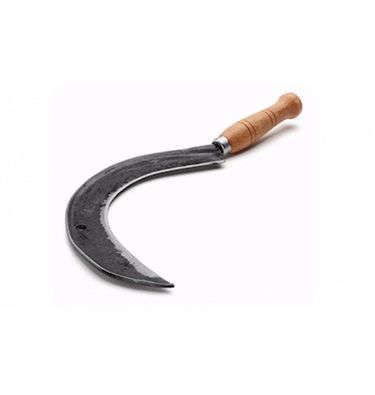

The sickle is one of the first tools man used in the garden. With sharp, curved blades and short handles, sickles were just as useful in the Iron Age as they are now to cut grass, mow down weeds, and keep order among the scrubby underbrush.
The sickle is one of the first tools man used in the garden. With sharp, curved blades and short handles, sickles were just as useful in the Iron Age as they are now to cut grass, mow down weeds, and keep order among the scrubby underbrush.
A Round Forged Sickle has a hand-forged blade sharpened on two sides and a hole for hanging in the toolshed; €29.50 from Manufactum.
A Round Forged Sickle has a hand-forged blade sharpened on two sides and a hole for hanging in the toolshed; €29.50 from Manufactum.
An Ultra-Light Grass Sickle is extremely sharp, designed to cut herbs and grasses.
An Ultra-Light Grass Sickle is extremely sharp, designed to cut herbs and grasses.
A Dutch-made DeWit Sickle has a carbon steel blade and hardwood handle; $74.58 via Amazon.
A Dutch-made DeWit Sickle has a carbon steel blade and hardwood handle; $74.58 via Amazon.
From Japan, a Munetoshi Sickle is lightweight and designed to cut grass and weeds.
From Japan, a Munetoshi Sickle is lightweight and designed to cut grass and weeds.
So it’s tidier, which is how they like things in Echigo,” notes Niwaki, where the sickle is £49.17 (£59 including VAT).
So it’s tidier, which is how they like things in Echigo,” notes Niwaki, where the sickle is £49.17 (£59 including VAT).
Ideal for cutting woody stems, tough grasses, and other “wild growth,” a Grim Sickle made in Germany has a lacquered beech handle and is €17.90 from Dictum.
Ideal for cutting woody stems, tough grasses, and other “wild growth,” a Grim Sickle made in Germany has a lacquered beech handle and is €17.90 from Dictum.
A stainless steel Serrated Blade Hand Sickle from Japan is lightweight and fitted with a hardwood handle.
A stainless steel Serrated Blade Hand Sickle from Japan is lightweight and fitted with a hardwood handle.
Suitable for cutting back perennials and woody shrubs with branches of up to 1 centimeter in diameter, a Japanese Perennials Sickle has an alloy chrome steel blade and a lightweight paulownia wood handle; €24.50 from Manufactum.
Suitable for cutting back perennials and woody shrubs with branches of up to 1 centimeter in diameter, a Japanese Perennials Sickle has an alloy chrome steel blade and a lightweight paulownia wood handle; €24.50 from Manufactum.
“Wicked little sickle from Aida, a small blacksmith up in Sanjo,” says Niwaki, which imports the hand tool from Japan.
“Wicked little sickle from Aida, a small blacksmith up in Sanjo,” says Niwaki, which imports the hand tool from Japan.
The Herbaceous Sickle has a serrated blade designed to prune fibrous stalks; £9.95 from Burgon & Ball.
The Herbaceous Sickle has a serrated blade designed to prune fibrous stalks; £9.95 from Burgon & Ball.
Made in Germany with a carbon steel blade and shank, a Sickle By SHW has a hardwood handle and is $22.50 from Garden Tool Company.
Made in Germany with a carbon steel blade and shank, a Sickle By SHW has a hardwood handle and is $22.50 from Garden Tool Company.